Abstract
Pigeons chose between two aperiodic, time-based schedules of reinforcement. The arithmetic mean interreinforcement interval of the first schedule was short, but the harmonic mean was long, whereas the arithmetic mean interreinforcement interval of the second schedule was long, but the harmonic mean was short. The pigeons preferred the schedule with the shorter harmonic mean in a concurrent-chains procedure when a terminal link ended after the first scheduled reinforcer had been gained on a terminal-link entry, but reversed their preferences, such that they preferred the schedule with the shorter arithmetic mean, when the terminal links ended after a fixed duration of exposure to the schedule. Moreover, the pigeons preferred the schedule with the shorter arithmetic mean in a two-key concurrent variable-interval variable-interval procedure, as well as in a concurrent variable-time variable-time, changeover-key procedure. The data suggest that an aggregate property of a schedule may not yield valid information about the responding that schedule will maintain as a choice alternative.
Keywords: choice, concurrent chains, concurrent schedules, changeover-key procedure, harmonic rate of reinforcement, key peck, pigeons
Full text
PDF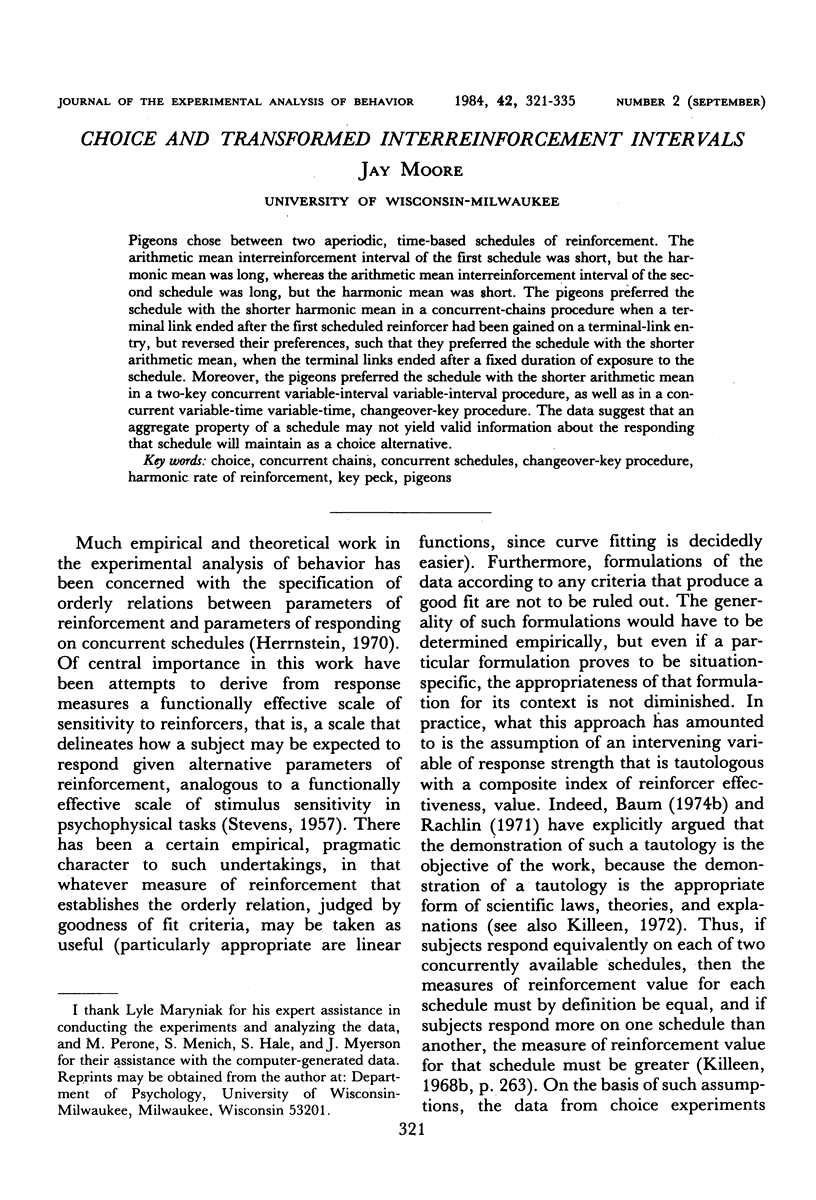
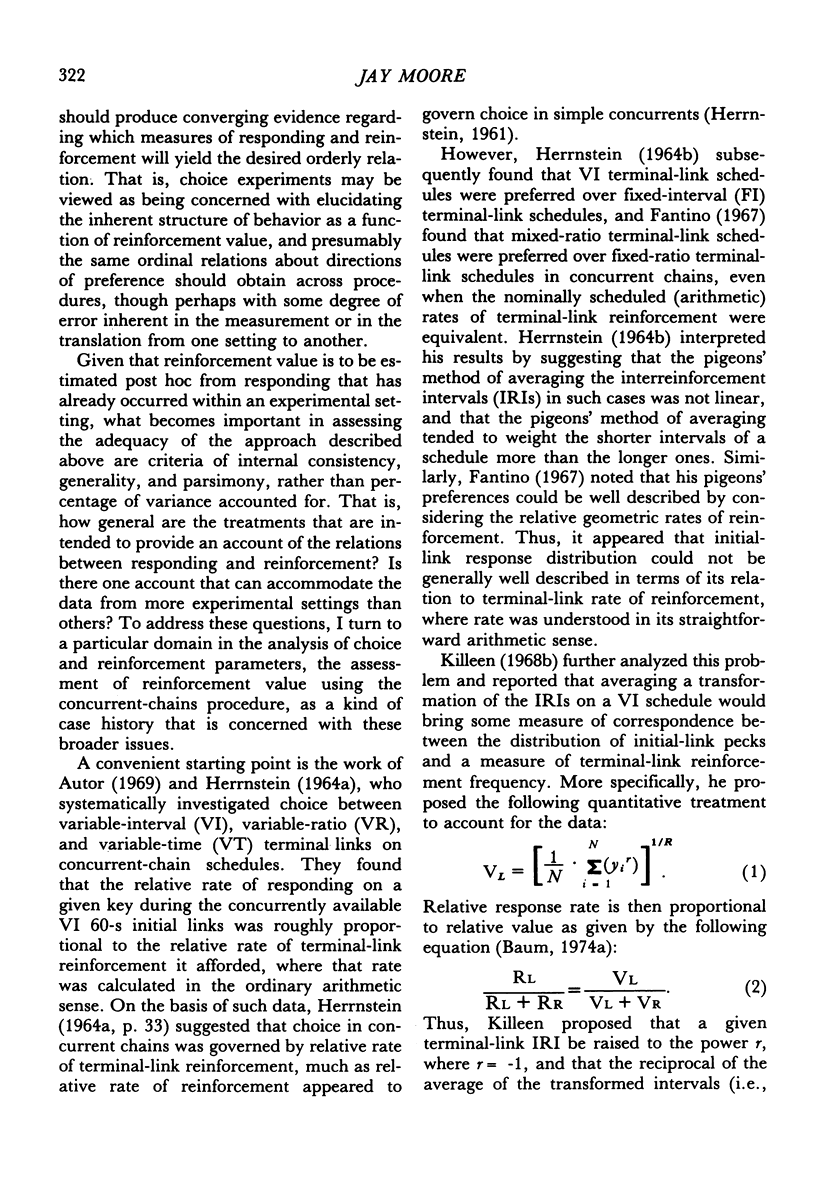
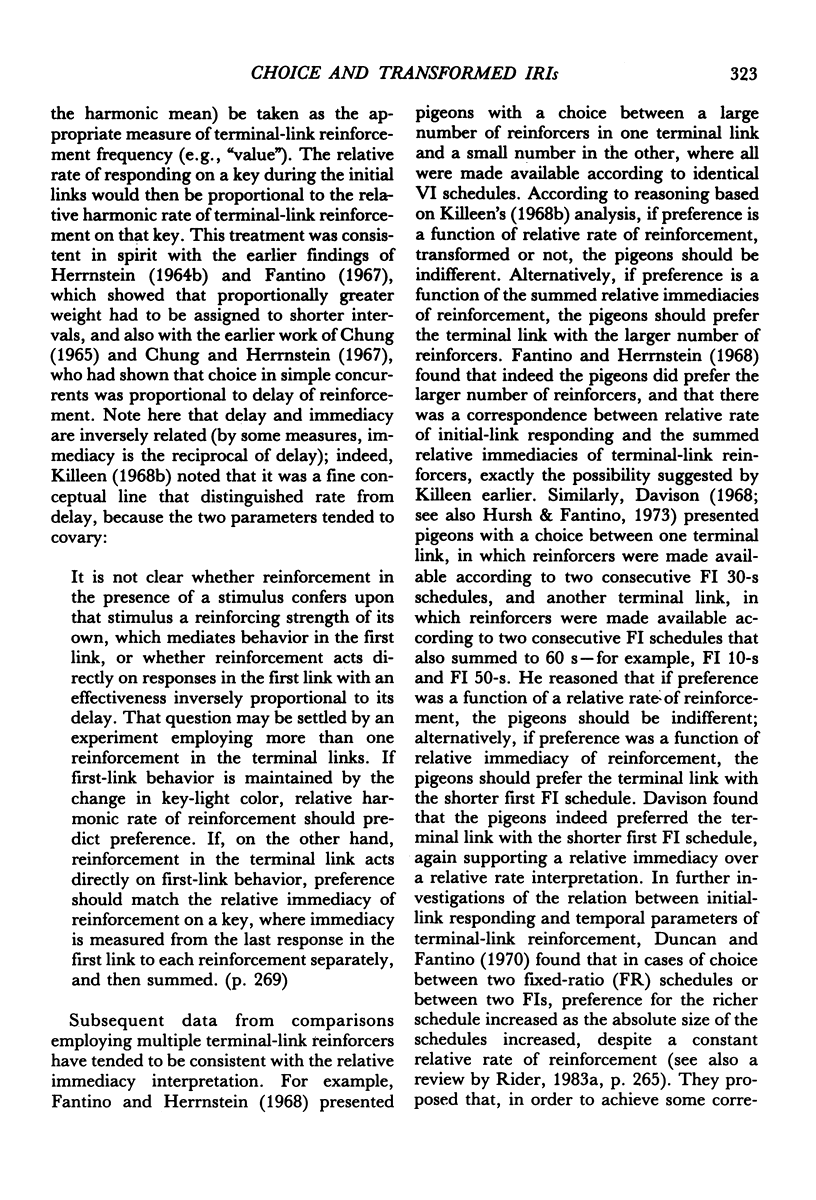
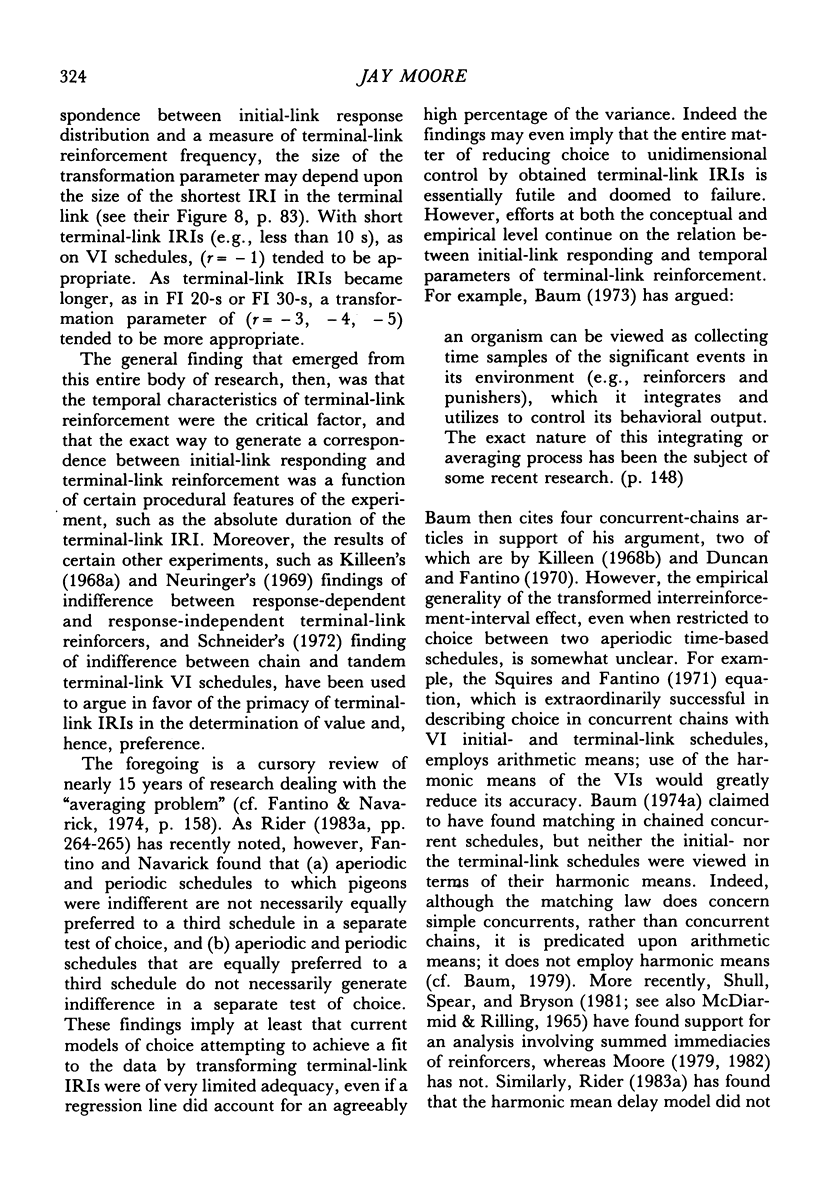
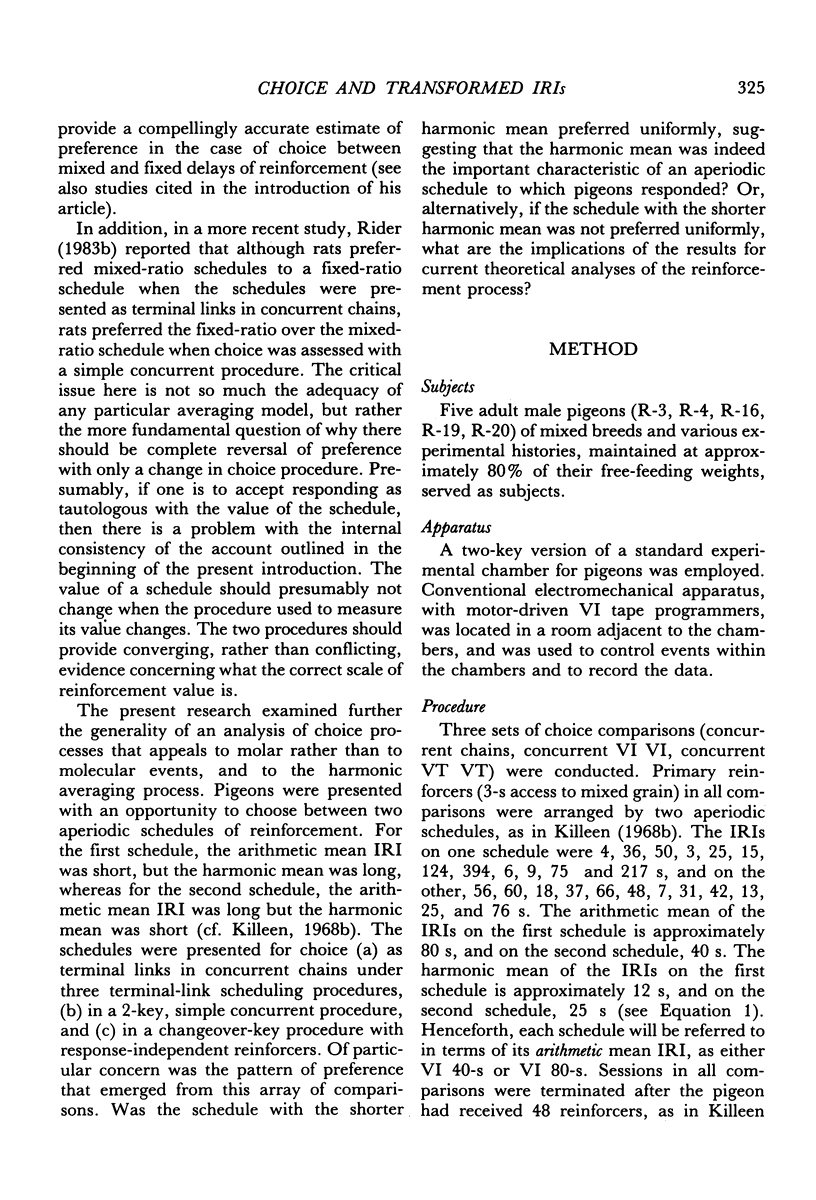
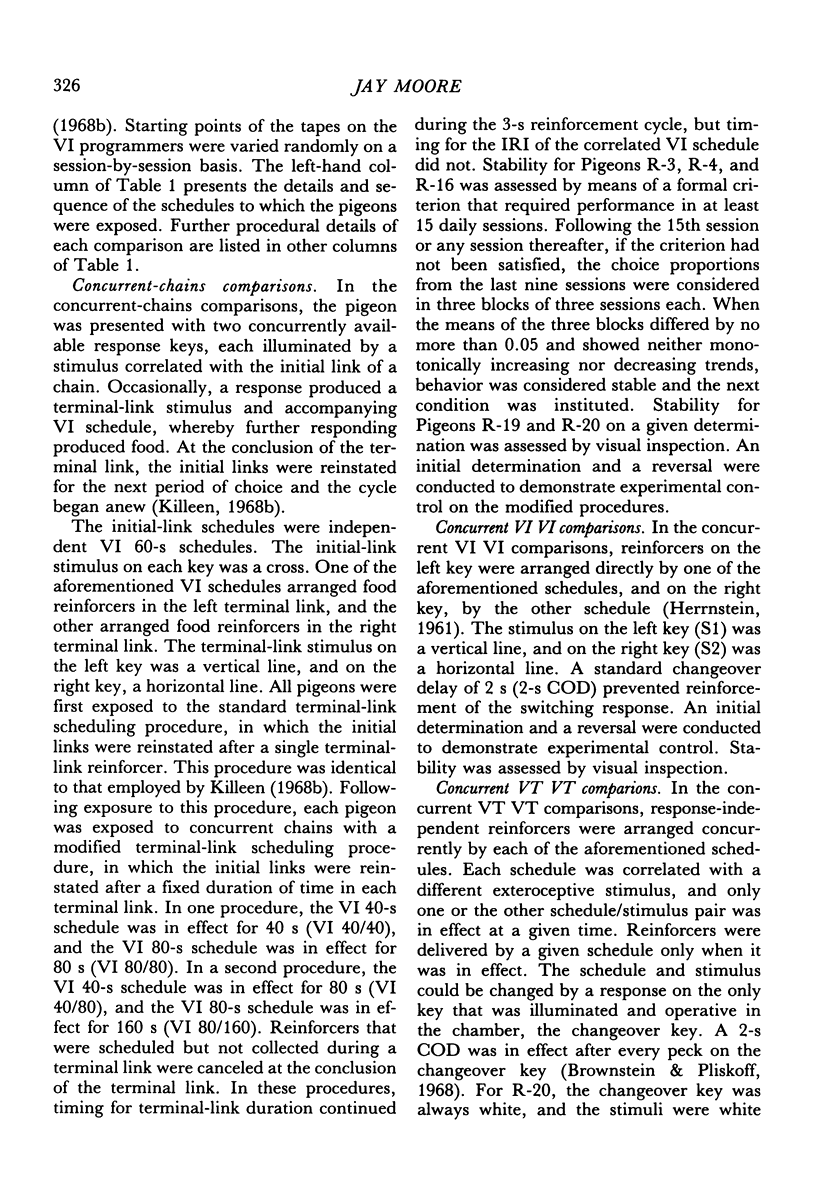
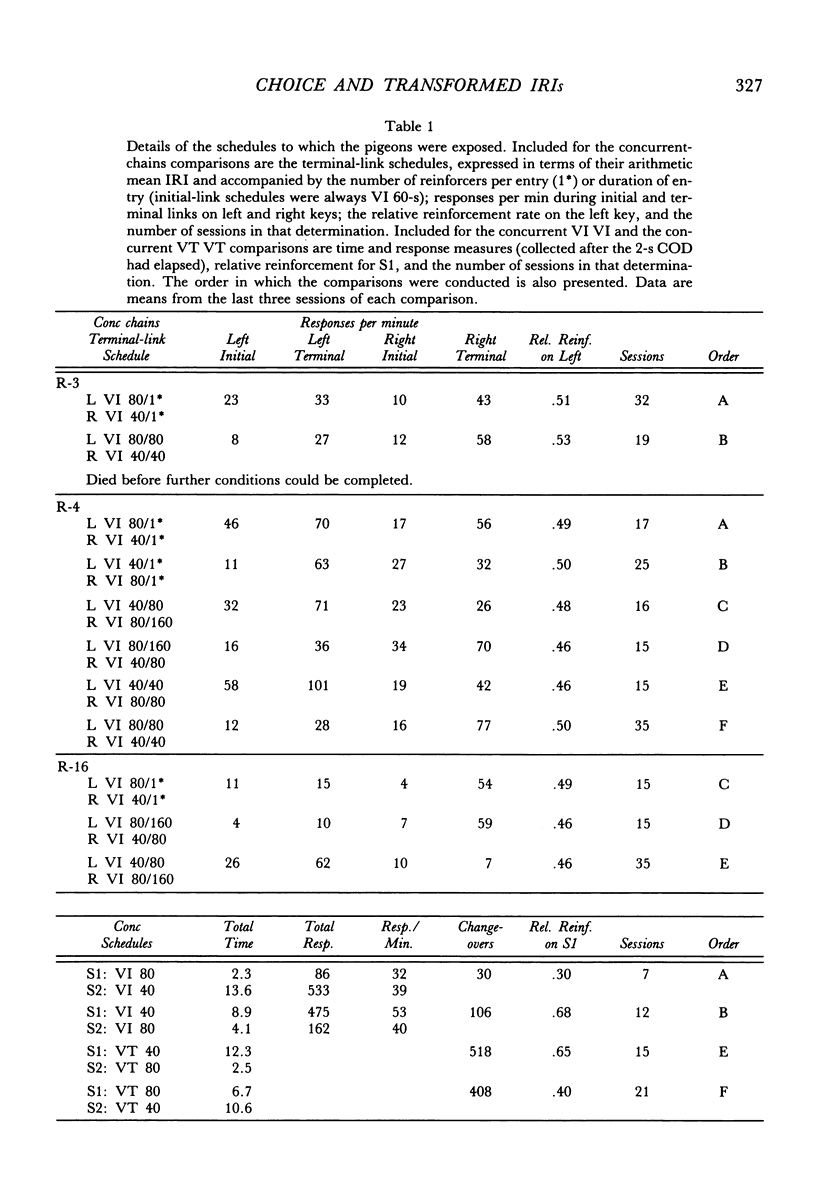

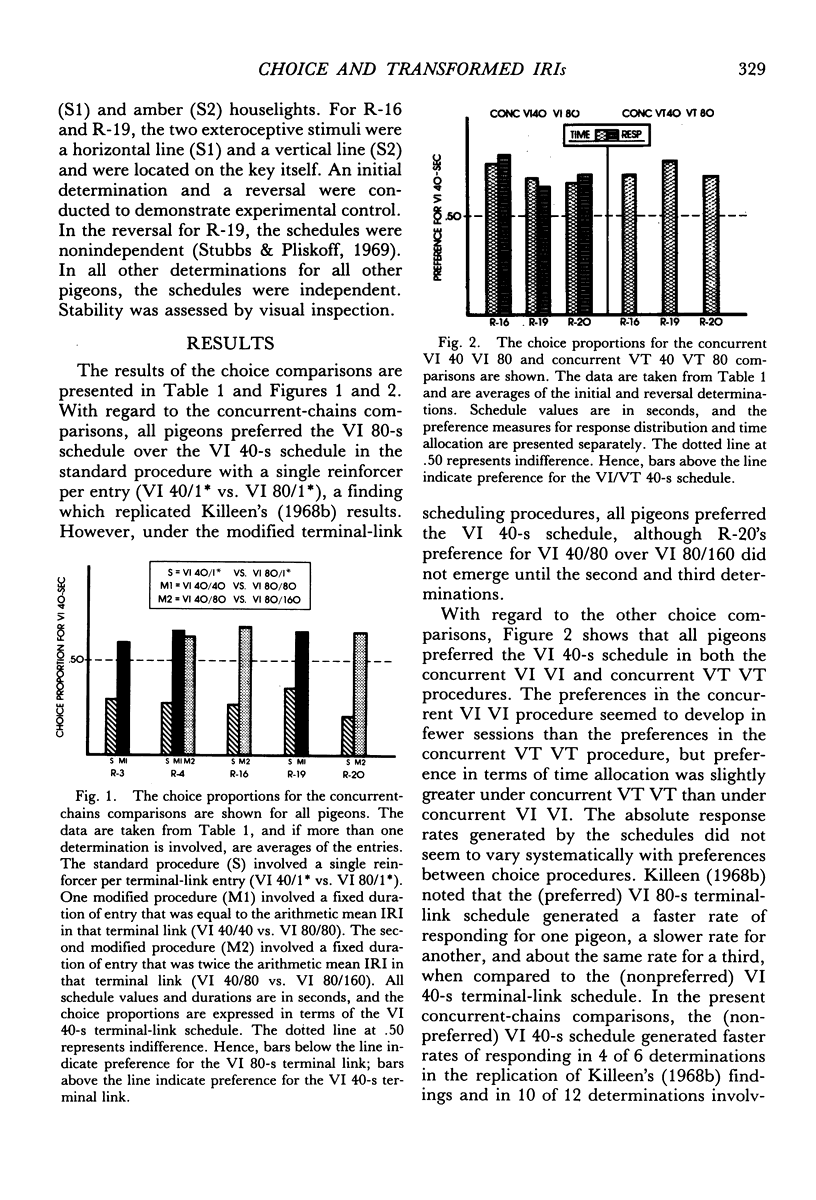

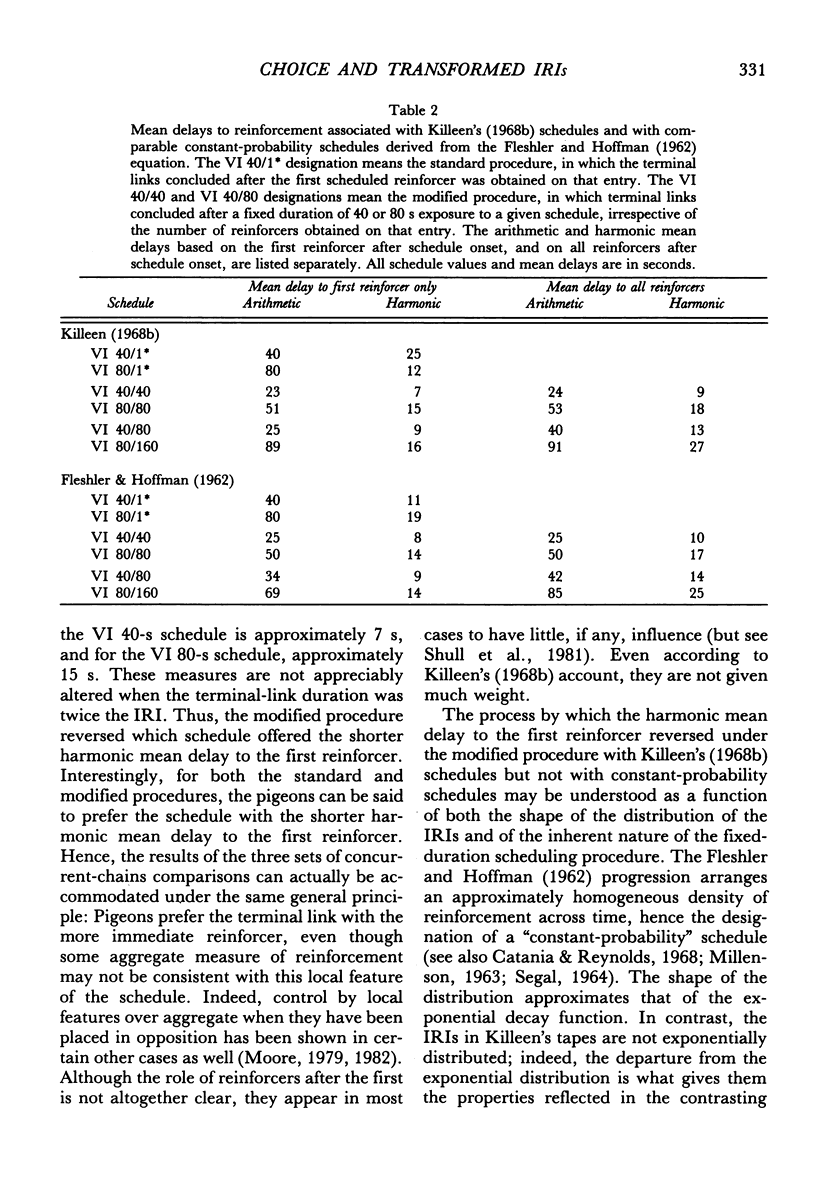
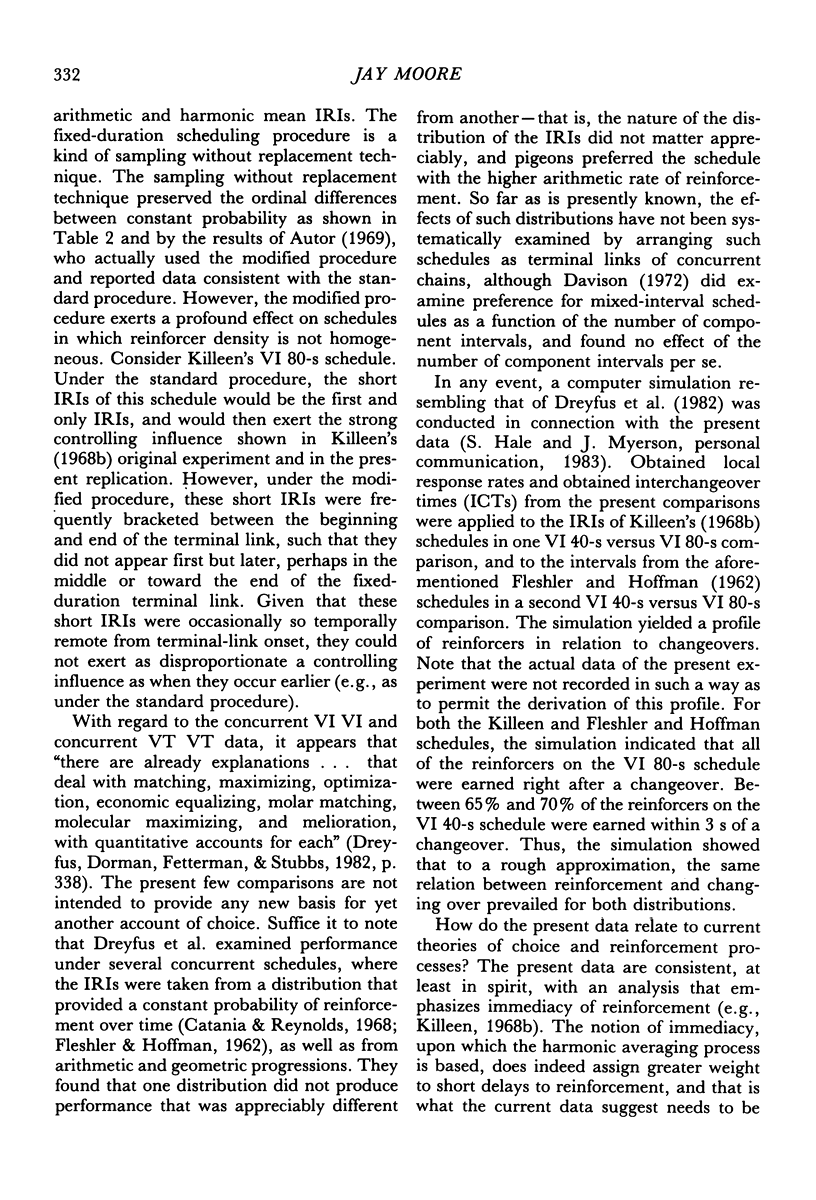
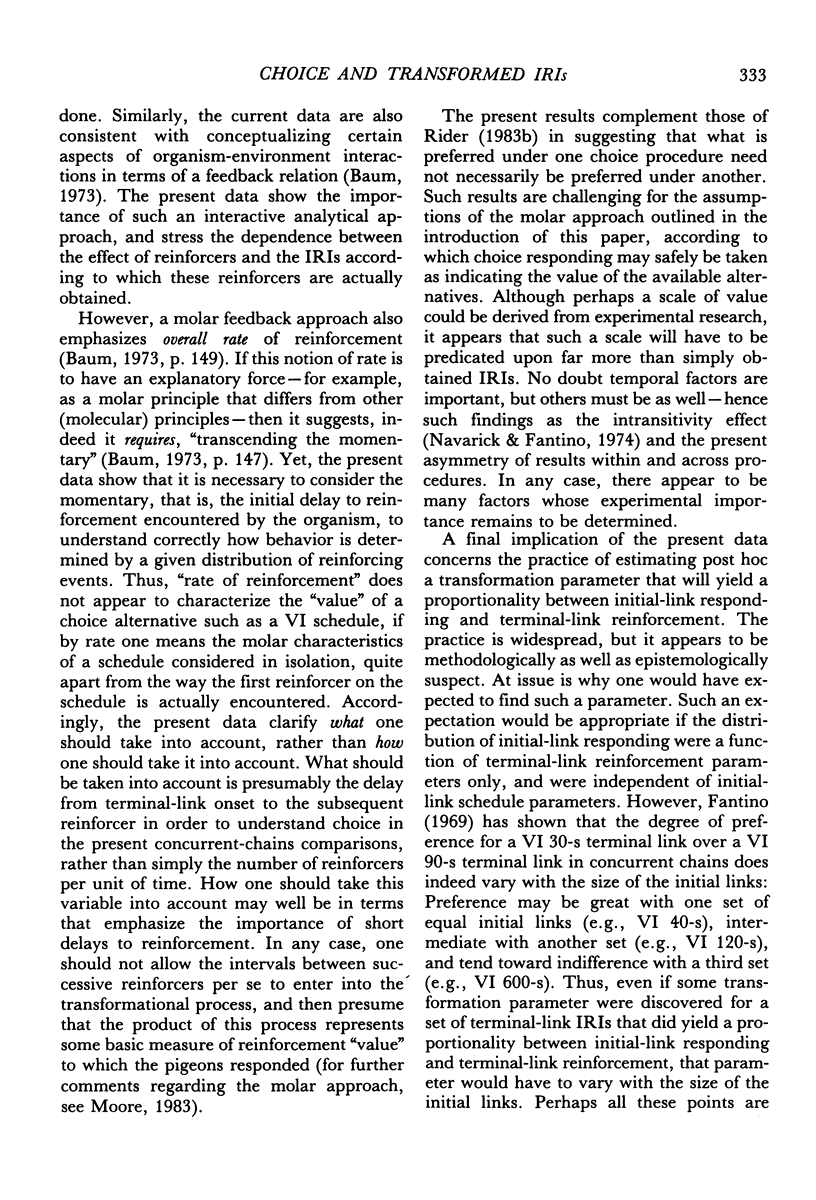
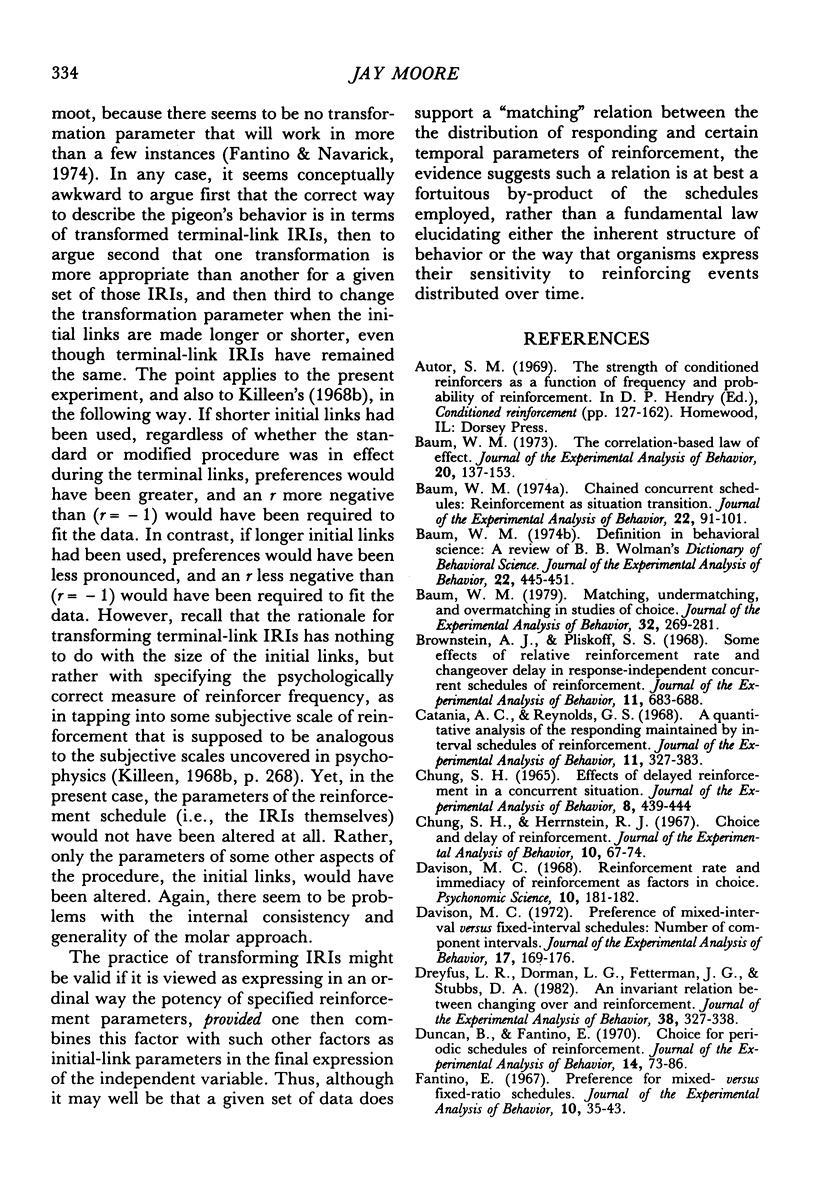
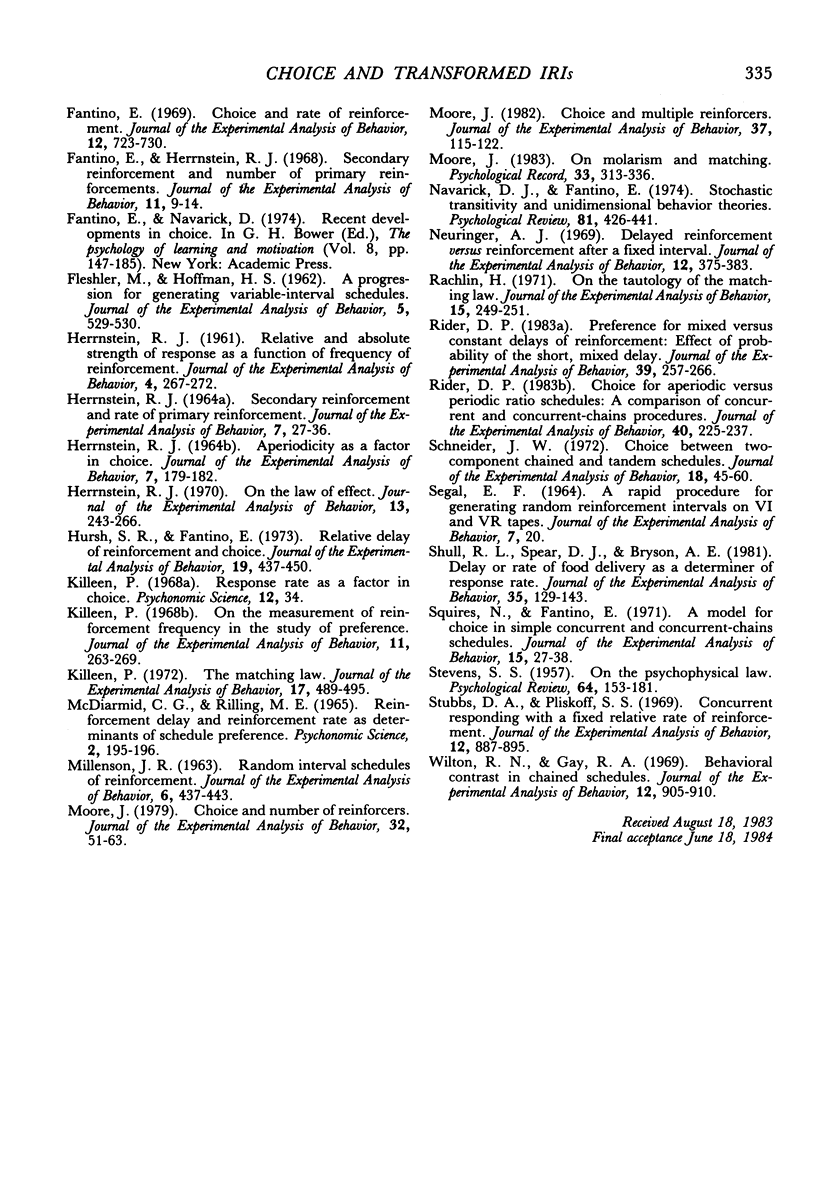
Selected References
These references are in PubMed. This may not be the complete list of references from this article.
- Baum W. M. Chained concurrent schedules: reinforcement as situation transition. J Exp Anal Behav. 1974 Jul;22(1):91–101. doi: 10.1901/jeab.1974.22-91. [DOI] [PMC free article] [PubMed] [Google Scholar]
- Baum W. M. Matching, undermatching, and overmatching in studies of choice. J Exp Anal Behav. 1979 Sep;32(2):269–281. doi: 10.1901/jeab.1979.32-269. [DOI] [PMC free article] [PubMed] [Google Scholar]
- Baum W. M. The correlation-based law of effect. J Exp Anal Behav. 1973 Jul;20(1):137–153. doi: 10.1901/jeab.1973.20-137. [DOI] [PMC free article] [PubMed] [Google Scholar]
- Brownstein A. J., Pliskoff S. S. Some effects of relative reinforcement rate and changeover delay in response-independent concurrent schedules of reinforcement. J Exp Anal Behav. 1968 Nov;11(6):683–688. doi: 10.1901/jeab.1968.11-683. [DOI] [PMC free article] [PubMed] [Google Scholar]
- Catania A. C., Reynolds G. S. A quantitative analysis of the responding maintained by interval schedules of reinforcement. J Exp Anal Behav. 1968 May;11(3 Suppl):327–383. doi: 10.1901/jeab.1968.11-s327. [DOI] [PMC free article] [PubMed] [Google Scholar]
- Chung S. H. Effects of delayed reinforcement in a concurrent situation. J Exp Anal Behav. 1965 Nov;8(6):439–444. doi: 10.1901/jeab.1965.8-439. [DOI] [PMC free article] [PubMed] [Google Scholar]
- Chung S. H., Herrnstein R. J. Choice and delay of reinforcement. J Exp Anal Behav. 1967 Jan;10(1):67–74. doi: 10.1901/jeab.1967.10-67. [DOI] [PMC free article] [PubMed] [Google Scholar]
- Davison M. C. Preference for mixed-interval versus fixed-interval schedules: number of component intervals. J Exp Anal Behav. 1972 Mar;17(2):169–176. doi: 10.1901/jeab.1972.17-169. [DOI] [PMC free article] [PubMed] [Google Scholar]
- Dreyfus L. R., Dorman L. G., Fetterman J. G., Stubbs D. A. An invariant relation between changing over and reinforcement. J Exp Anal Behav. 1982 Nov;38(3):327–338. doi: 10.1901/jeab.1982.38-327. [DOI] [PMC free article] [PubMed] [Google Scholar]
- Duncan B., Fantino E. Choice for periodic schedules of reinforcement. J Exp Anal Behav. 1970 Jul;14(1):73–86. doi: 10.1901/jeab.1970.14-73. [DOI] [PMC free article] [PubMed] [Google Scholar]
- FLESHLER M., HOFFMAN H. S. A progression for generating variable-interval schedules. J Exp Anal Behav. 1962 Oct;5:529–530. doi: 10.1901/jeab.1962.5-529. [DOI] [PMC free article] [PubMed] [Google Scholar]
- Fantino E. Choice and rate of reinforcement. J Exp Anal Behav. 1969 Sep;12(5):723–730. doi: 10.1901/jeab.1969.12-723. [DOI] [PMC free article] [PubMed] [Google Scholar]
- Fantino E., Herrnstein R. J. Secondary reinforcement and number of primary reinforcements. J Exp Anal Behav. 1968 Jan;11(1):9–14. doi: 10.1901/jeab.1968.11-9. [DOI] [PMC free article] [PubMed] [Google Scholar]
- Fantino E. Preference for mixed- versus fixed-ratio schedules. J Exp Anal Behav. 1967 Jan;10(1):35–43. doi: 10.1901/jeab.1967.10-35. [DOI] [PMC free article] [PubMed] [Google Scholar]
- HERRNSTEIN R. J. APERIODICITY AS A FACTOR IN CHOICE. J Exp Anal Behav. 1964 Mar;7:179–182. doi: 10.1901/jeab.1964.7-179. [DOI] [PMC free article] [PubMed] [Google Scholar]
- HERRNSTEIN R. J. Relative and absolute strength of response as a function of frequency of reinforcement. J Exp Anal Behav. 1961 Jul;4:267–272. doi: 10.1901/jeab.1961.4-267. [DOI] [PMC free article] [PubMed] [Google Scholar]
- HERRNSTEIN R. J. SECONDARY REINFORCEMENT AND RATE OF PRIMARY REINFORCEMENT. J Exp Anal Behav. 1964 Jan;7:27–36. doi: 10.1901/jeab.1964.7-27. [DOI] [PMC free article] [PubMed] [Google Scholar]
- Herrnstein R. J. On the law of effect. J Exp Anal Behav. 1970 Mar;13(2):243–266. doi: 10.1901/jeab.1970.13-243. [DOI] [PMC free article] [PubMed] [Google Scholar]
- Hursh S. R., Fantino E. Relative delay of reinforcement and choice. J Exp Anal Behav. 1973 May;19(3):437–450. doi: 10.1901/jeab.1973.19-437. [DOI] [PMC free article] [PubMed] [Google Scholar]
- Killeen P. On the measurement of reinforcement frequency in the study of preference. J Exp Anal Behav. 1968 May;11(3):263–269. doi: 10.1901/jeab.1968.11-263. [DOI] [PMC free article] [PubMed] [Google Scholar]
- Killeen P. The matching law. J Exp Anal Behav. 1972 May;17(3):489–495. doi: 10.1901/jeab.1972.17-489. [DOI] [PMC free article] [PubMed] [Google Scholar]
- Millenson J. R. Random interval schedules of reinforcement. J Exp Anal Behav. 1963 Jul;6(3):437–443. doi: 10.1901/jeab.1963.6-437. [DOI] [PMC free article] [PubMed] [Google Scholar]
- Moore J. Choice and multiple reinforcers. J Exp Anal Behav. 1982 Jan;37(1):115–122. doi: 10.1901/jeab.1982.37-115. [DOI] [PMC free article] [PubMed] [Google Scholar]
- Moore J. Choice and number of reinforcers. J Exp Anal Behav. 1979 Jul;32(1):51–63. doi: 10.1901/jeab.1979.32-51. [DOI] [PMC free article] [PubMed] [Google Scholar]
- Neuringer A. J. Delayed reinforcement versus reinforcement after a fixed interval. J Exp Anal Behav. 1969 May;12(3):375–383. doi: 10.1901/jeab.1969.12-375. [DOI] [PMC free article] [PubMed] [Google Scholar]
- doi: 10.1901/jeab.1974.22-445. [DOI] [PMC free article] [Google Scholar]
- Rachlin H. On the tautology of the matching law. J Exp Anal Behav. 1971 Mar;15(2):249–251. doi: 10.1901/jeab.1971.15-249. [DOI] [PMC free article] [PubMed] [Google Scholar]
- Rider D. P. Choice for aperiodic versus periodic ratio schedules: A comparison of concurrent and concurrent-chain procedures. J Exp Anal Behav. 1983 Nov;40(3):225–237. doi: 10.1901/jeab.1983.40-225. [DOI] [PMC free article] [PubMed] [Google Scholar]
- Rider D. P. Preference for mixed versus constant delays of reinforcement: Effect of probability of the short, mixed delay. J Exp Anal Behav. 1983 Mar;39(2):257–266. doi: 10.1901/jeab.1983.39-257. [DOI] [PMC free article] [PubMed] [Google Scholar]
- SEGAL E. F. A RAPID PROCEDURE FOR GENERATING RANDOM REINFORCEMENT INTERVALS ON VI AND VR TAPES. J Exp Anal Behav. 1964 Jan;7:20–20. doi: 10.1901/jeab.1964.7-20. [DOI] [PMC free article] [PubMed] [Google Scholar]
- STEVENS S. S. On the psychophysical law. Psychol Rev. 1957 May;64(3):153–181. doi: 10.1037/h0046162. [DOI] [PubMed] [Google Scholar]
- Schneider J. W. Choice between two-component chained and tandem schedules. J Exp Anal Behav. 1972 Jul;18(1):45–60. doi: 10.1901/jeab.1972.18-45. [DOI] [PMC free article] [PubMed] [Google Scholar]
- Shull R. L., Spear D. J., Bryson A. E. Delay or rate of food delivery as determiners of response rate. J Exp Anal Behav. 1981 Mar;35(2):129–143. doi: 10.1901/jeab.1981.35-129. [DOI] [PMC free article] [PubMed] [Google Scholar]
- Squires N., Fantino E. A model for choice in simple concurrent and concurrent-chains schedules. J Exp Anal Behav. 1971 Jan;15(1):27–38. doi: 10.1901/jeab.1971.15-27. [DOI] [PMC free article] [PubMed] [Google Scholar]
- Stubbs D. A., Pliskoff S. S. Concurrent responding with fixed relative rate of reinforcement. J Exp Anal Behav. 1969 Nov;12(6):887–895. doi: 10.1901/jeab.1969.12-887. [DOI] [PMC free article] [PubMed] [Google Scholar]
- Wilton R. N., Gay R. A. Behavioral contrast in chained schedules. J Exp Anal Behav. 1969 Nov;12(6):905–910. doi: 10.1901/jeab.1969.12-905. [DOI] [PMC free article] [PubMed] [Google Scholar]


